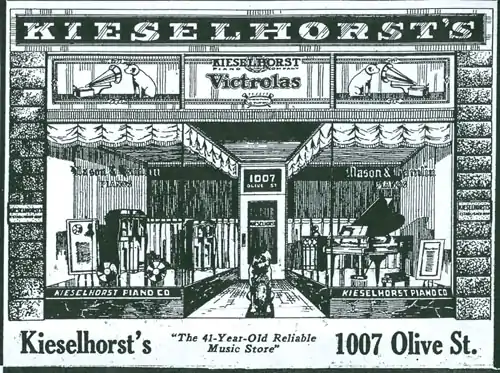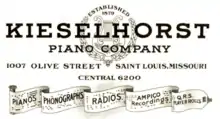Kieselhorst Piano Company
The Kieselhorst Piano Company was an American manufacturer and vendor of pianos and publisher of sheet music that operated from 1879 to 1930 in Saint Louis, Missouri.[1]

 Detail from letterhead, 1925 | |
| Formerly | Olhausen & Kieselhorst |
|---|---|
| Industry | musical instrument manufacture |
| Founded | 1879 |
| Founder | John A. Kieselhorst |
| Defunct | 1930 |
| Fate | closed |
| Headquarters | Saint Louis, Missouri , United States |
| Products | Pianos, sheet music |
| Brands | Kieselhorst |
| Owner | John A. Kieselhorst, Edwin A. Kieselhorst |
Number of employees | 26 (1902) |
History
The company was founded by John A. Kieselhorst Jr., born in 1844 to John A. Kieselhorst and his wife,[2] German immigrants to St. Louis.[3] A carpenter's son, he left that trade to become a bank teller and then a bookkeeper. In 1879, he and Ernst P. Olhausen, then assistant editor of the Westliche Post, opened Olhausen & Kieselhorst, a store that sold "pianos, organs, musical instruments, music, books, and stationary" at 10 South Fourth Street.[3] After six months, Kieselhorst bought out his partner, struck his name from the business, and moved the shop to 2706 Laclede Avenue in the Mill Creek Valley neighborhood.[4] In 1881, he began selling Henry Miller Pianos, made in Boston. Three years later, he moved the business to 1111 Olive Street, in the city's growing piano district.[4] He sold pianos by William Knabe & Company (made in New York City), Kimball & Company (Chicago), and Blasius & Sons (Woodbury, New Jersey). By 1893, he was able to move the store to a more prominent space at the southwest comer of Olive and Tenth. Kieselhorst ran the company until 1895, when he died at age 51.[3]
His 21-year-old son Edwin Artus Kieselhorst[5] took over the company. "He greatly expanded the company's services to consist not only of dealing traditional pianos and organs but of manufacturing pianos and piano parts, polishing, tuning, and storing," according to its National Register of Historic Places registration form.[3] The company thus became one of the city's earliest piano manufacturers,[3] though it continued to sell other brands as well. Edwin vigorously pushed the company into new technologies such as the player piano and, later, the victrola. In 1898, Edwin incorporated the firm as Kieselhorst Piano Company.
By 1902, Edwin had doubled the company's annual sales and expanded its workforce to 26 people. One younger brother became the manager in the player-piano department; another, the foreman in the electric piano department. The company also developed a self-playing attachment for use on pianos and organs.
In 1906,[3] Edwin moved the company headquarters to 1007 Olive Street, an 1890 office building "in the heart of Saint Louis' dense and most elite music district on Olive between Ninth and Twelfth Streets which had thrived since the early 1880s."[1]
In 1913, the company advertised pianos of its own branding, offering the "Kieselhorst Upright Piano" for $275 ($7,540 today[6]).[7] Other advertisements offered the "Style 90 Kieselhorst Player-Piano" and the "Style 36 Kieselhorst Upright".[8]
In 1925, the company was selling pianos by Mason & Hamlin, Sohmer, Kurtzmann, Haines Brothers, and Gulbransen; phonographs by Victrola and Brunswick; and radios, including the Super Zenith Long Distance Radio and the Brunswick Radiola.[4]
By the late 1920s, the Kieselhorst Piano Company's revenues were dwindling along with national sales of pianos, and in 1930 Edwin Kieselhorst decided to dissolve the company while it remained financially sound.[1] "Having observed the decline of the piano and musical instrument business for many years, we have decided to retire cheerfully and gracefully with substantial assets, no liabilities, and a pride in the family name," he said.[3]
Kieselhorst family
John Kieselhorst who was "considered the city's finest flute player",[9] was also a published composer of works for piano and flute.[10] He had a sister, Emma T. Kieselhorst (1849-1915), a schoolteacher.[11] She left an estate of $4,000 ($107,145 today[6]), most of which she bequeathed to various charities.[12]
Besides Edwin, John's children included Henry Kieselhorst, who in 1940 operated a company at 6816 Easton Avenue (now Dr. Martin Luther King Drive) in St. Louis.[9]
Edwin Kieselhorst was born in St. Louis in 1875. In 1900, Edwin eloped with Estelle Williams, a cashier at his company; they married in Little Rock, Arkansas, and came back to live in his house at 4365 Forest Park Boulevard.[13] In 1926, he and his wife took a four-month vacation to the South Sea Islands; he returned "weighing thirteen and one half pounds more than when he went away and looking as fit as a fiddle."[14] In 1940, he was living at 12 Southmoor Drive[15] in Clayton, Missouri. He died on November 12, 1940, of a heart attack while leaving a friend's house at 7314 Westmoreland Drive in University City, Missouri, and was buried in Bellefontaine Cemetery in St. Louis.[9]
Legacy
In 2008, the Romanesque five-story brick building at 1007 Olive, long known as the Kieselhorst Piano Company Building, was placed on the National Register of Historic Places.[3] "Today it is one of the few architectural remnants of the heyday of the music industry in Saint Louis and a reminder of the cultural forces that propelled that industry into being," including the piano company that "was representative of the major influence of German culture upon the musical tastes and practices of the city," according to its National Register of Historic Places registration form.[3]
External links
- Compositions (St. Louis: Kunkel Brothers, 1891), a set of piano and flute solos composed by John Kieselhorst
- Bio of Edwin Kieselhorst[16]
Notes
- "Landmarks Association of St. Louis :: News :: Kieselhorst Piano Company Listed in the National Register of Historic Places". www.landmarks-stl.org. Retrieved 2022-04-21.
- "4 Nov 1915, Page 3 - St. Louis Post-Dispatch at Newspapers.com". Newspapers.com. Retrieved 2022-04-25.
- "National Register of Historic Places Registration Form" (PDF). Missouri Department of Natural Resources. Retrieved 2022-04-21.
- "Music Trade Review: MTR-1925-80-13". mtr.arcade-museum.com. Retrieved 2022-04-22.
- "Genealogy and Local History Index | Missouri Historical Society". genealogy.mohistory.org. Retrieved 2022-04-22.
- 1634–1699: McCusker, J. J. (1997). How Much Is That in Real Money? A Historical Price Index for Use as a Deflator of Money Values in the Economy of the United States: Addenda et Corrigenda (PDF). American Antiquarian Society. 1700–1799: McCusker, J. J. (1992). How Much Is That in Real Money? A Historical Price Index for Use as a Deflator of Money Values in the Economy of the United States (PDF). American Antiquarian Society. 1800–present: Federal Reserve Bank of Minneapolis. "Consumer Price Index (estimate) 1800–". Retrieved April 16, 2022.
- "7 Dec 1913, Page 20 - St. Louis Post-Dispatch at Newspapers.com". Newspapers.com. Retrieved 2022-04-25.
- "4 May 1913, Page 34 - St. Louis Post-Dispatch at Newspapers.com". Newspapers.com. Retrieved 2022-04-25.
- "12 Nov 1940, Page 10 - St. Louis Post-Dispatch at Newspapers.com". Newspapers.com. Retrieved 2022-04-23.
- Kieselhorst, J. A. (1891). Love's whisperings : valse caprice. St. Louis : Kunkel Brothers, publishers.
- "4 Nov 1915, Page 3 - St. Louis Post-Dispatch at Newspapers.com". Newspapers.com. Retrieved 2022-04-25.
- "8 Nov 1915, Page 2 - The St. Louis Star and Times at Newspapers.com". Newspapers.com. Retrieved 2022-04-25.
- "14 Nov 1900, Page 1 - St. Louis Post-Dispatch at Newspapers.com". Newspapers.com. Retrieved 2022-04-23.
- "Music Trade Review: MTR-1926-82-18-SECTION-1". mtr.arcade-museum.com. Retrieved 2022-04-25.
- The 10-room brick house was built in 1920."12 Southmoor Dr, Clayton, MO 63105 - MLS 22014716 - Coldwell Banker". ColdwellBankerHomes.com. Retrieved 2022-04-25.
- Marquis, Albert Nelson (1912). The Book of St. Louisans: A Biographical Dictionary of Leading Living Men of the City of St. Louis and Vicinity. St. Louis republic.